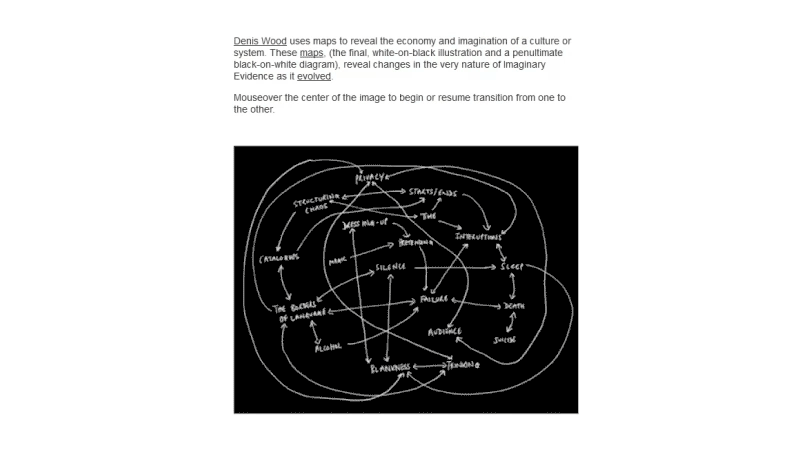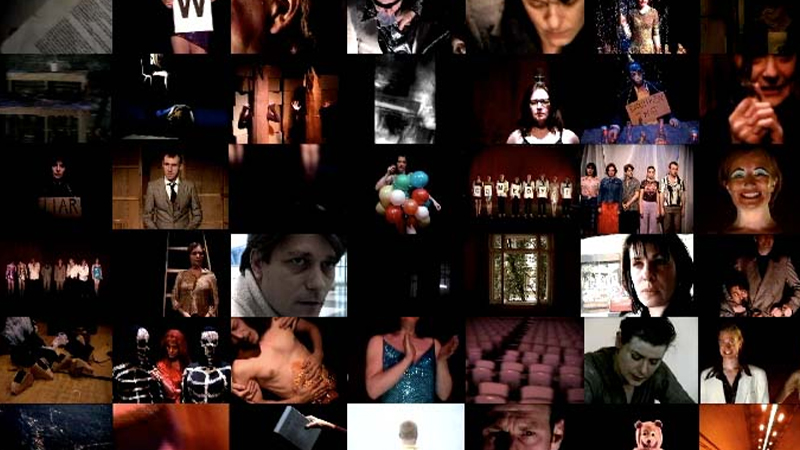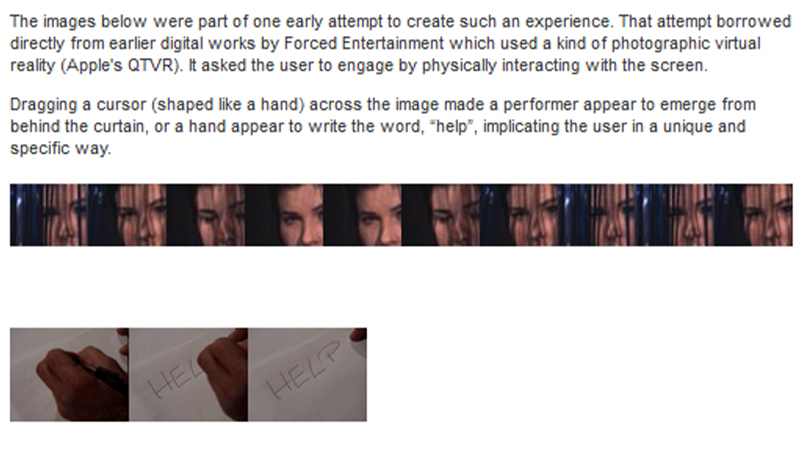Editor's Introduction
"On the surface, Investigating Imaginary Evidence documents the intensive creative process behind Forced Entertainment's construction of a CD-ROM project in detail, helping chart the debates and interactions among collaborators in order to demonstrate the eventual synthesis of key ideas that make the project what it is. However, Investigating Imaginary Evidence goes well beyond merely offering an extensive behind-the-scenes examination of the intricate matrix of reflections about creativity, interactivity, and the status of 'evidence' to embody a larger issue, namely the phenomenological relationship between creator and user.
Using a pared back, minimal aesthetic, the hypertext structure brings to the fore the generous reaching out of both creator and user; both move towards each other in a reciprocal dance of questioning and answering, of offering and receiving, each invested in the conjuring of imaginary evidence. The results of the investigation are not a given; instead, they emerge gradually.
While this issue of Vectors is about evidence, it is difficult not to reflect on the 'imaginary' in the title of this project. 'Imaginary' here isn't just the whimsical musings contained in a mind, but might reference as well Lacan's imaginary, the place where boundaries dissolve in a fluid matrix. What is the imaginary of evidence in this context? In its thematizing of user/creator intersection, Investigating Imaginary Evidence helps point us toward an answer." – Tara McPherson and Steve Anderson, Vectors Editors
Author's Statement
"Investigating Imaginary Evidence:
What can ever truly represent
evidence of nearly twenty years creating work in performance,
installation, live art and digital media? What separates archive from
experience? Is there ever an appropriate balance between fiction and
information? Forced Entertainment's recent CD-ROM, Imaginary Evidence, grew from those questions.
Declaring
evidence as imaginary immediately places it in a position to be
contested, disbelieved, used for one's own means. How we, as users,
separate that work from which a piece of video or text has evolved and
the narrative emerging before us defines our experience of Imaginary Evidence.
How those negotiations were constructed and what decisions were made
to shape possible outcomes are concerns that drive this work, Investigating Imaginary Evidence.
As
the digital author of this and other of Forced Entertainment's
interactive projects, I often worked quite far away from the rest of the
company, meeting only periodically during the development of
interactive projects to participate in intensely focused but rather rare
collaborative periods. Imaginary Evidence, however, grew from a
large series of meetings with the entire company and key collaborators
over a number of years. Those meetings were speculative and
evolutionary. They led to numerous periods of intensive work,
negotiations and discussions. Those elements drove the creation of Imaginary Evidence,
taking it, in many ways, into the territory of devising performance.
That developmental process, its reliance on certain elements used in the
creating of performance and its duration, was extraordinary, complex
and revelatory.
Digital media is often used to document or
provide some form of evidence of live performance, installation and
other less tangible media. Investigating Imaginary Evidence,
like the CD and creative processes upon which its investigations are
based, seeks to utilize the very things that confound our readings of
evidence. The user is asked to participate by utilizing memory,
structure and placement to discover otherwise invisible elements of a
creative process. Investigating Imaginary Evidence affords
access to some of those fluid, fluctuating and unique discussions (and
negotiations) that involved the entire company and collaborators of
Forced Entertainment.
The design of Investigating Imaginary Evidence
purposefully relies only upon the simplest of browser conventions (the
pull-down menu and text-based links) as its primary interface. The
screen has been stripped of decoration in an attempt to leave only a
textual or interactive element and negative space upon which you, the
user, may project your own structure, constructions and connections. The
questions and revisions that evolved from developing Imaginary Evidence exist here as a series of inter-connected elements each alluding to another and all a part of the whole.
-- Mary Agnes Krell
Mary
Agnes Krell is a Senior Lecturer in Digital Media Practice and Theory
at the University of Sussex. She has worked as a digital author and
artist in the UK and the USA for over a decade and has been an associate
member of England's Forced Entertainment. More information about Mary
Agnes and her current research including Lee Miller: Echoes of St. Malo is available online at: http://www.sussex.ac.uk/Users/mak23/" -- from Vectors, Volume 1, Issue 1, Fall 2005
Project Credits
"Work on Investigating Imaginary Evidence was influenced, in part, by my AHRB-Funded generative film experiment, The Somnambulist.
It was also made possible through the generous support of Dr. Caroline
Bassett, the School of Humanities Research Fund at Sussex University,
The Diamond Family Archive, Dr. Petra Gemeinboeck, Daniel Gosling,
Forced Entertainment and (of course) Tim Etchells." -- from Vectors, Volume 1, Issue 1, Fall 2005
1 COPY IN THE NEXT
Published in Fall, 2005 by Vectors in Volume 1, Issue 1.
This copy was given to the Electronic Literature Lab by Erik Loyer in November of 2021.
PUBLICATION TYPE
Online Journal
COPY MEDIA FORMAT
Web


